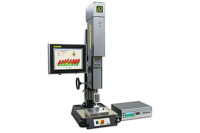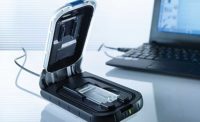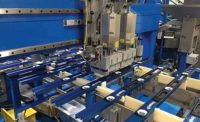Welded plastic cylinders are the lifeblood of British manufacturers Harvey Softeners Ltd. and Wavin Ltd. Harvey produces pressure tanks for its water softeners, while Wavin makes plastic tubes that connect to below-ground drainage systems.
Both companies injection-mold their product housings in two halves and then weld them using short-wave infrared emitters from Heraeus Noblelight, based in Hanau, Germany. These emitters produce a quick, clean weld by accurately transmitting infrared heat onto a plastic part surface or edge.
Initially, Harvey Softeners used a hot-plate welder to assemble glass-filled
polypropylene tanks. The problem with this method was its high melt temperatures (210 C to 250 C) exposed the glass fibers, which abraded the plate’s PTFE coating and reduced plate wear life.
Several years ago, the company switched to noncontact infrared welding to prevent plastic adhesion to the heating surface. The welding process begins with a worker positioning a moveable platen between the butt ends of fixtured opposing cylinders. Two banks of emitters are clamped and spring-loaded on either side of the platen.
After the worker switches on the power, infrared energy is initiated and applied only to the joint area of each part half. Within 40 seconds, melt temperature is achieved, and the material transitions to a molten state.
The fixtures open automatically, the platen is withdrawn and the power switched off. After the fixtures close, the butt ends are brought together under pressure to create the weld. When the cylinder is cool, the fixtures open and the part is removed.
The welded cylinder can withstand internal pressures of around 28 bar before bursting. In fact, the cylinder body will break under pressure well before the welded joint.
Harvey Softeners likes the high production capability and process flexibility of infrared welding. Short-wave emitters transfer huge amounts of energy quickly, resulting in cycle times of less than one minute. When welding wider-diameter cylinders, the manufacturer uses larger platens with more emitters.
For Wavin, infrared welding produces higher quality tubes and is more cost-effective than hot melt adhesives. It also helps the company better meet Britain’s stringent environmental protection requirements for tubes that connect to below-ground plastic or clay drainage systems.
Welding is done in an automated workcell featuring a robot and moveable platen. Loaded on the platen are very small emitters with a synthetic quartz glass coating that increases energy efficiency during welding.
Several tube halves are brought into the cell by the robot and welded together in only 22 seconds. This very short cycle time has significantly increased tube production. Wavin also likes that infrared heat creates significantly less fumes than hot-melt adhesives.
Heraeus Noblelight offers a wide range of infrared emitters and modules. Each emitter can be adjusted to match the shape, size and wavelength spectrum of the specific plastic part being welded. Modules are designed for industrial processes and feature emitters in specially designed housings with control units.
The company also performs system engineering and commissioning services. For more information on these products and services, call 678-835-5764 or visit www.heraeus-noblelight.com.




